Evaluating Market Structures and Government Policies in Business
VerifiedAdded on 2023/06/13
|13
|2905
|176
Report
AI Summary
This report analyzes various aspects of economics for business, focusing on market structures and government policies. It begins by examining the impact of increased excise duty on tobacco in Australia, using demand and supply curves to illustrate the effects on price and quantity. The report then discusses the price elasticity of demand for tobacco and determines that buyers bear the tax burden due to inelastic demand. Furthermore, it calculates the ATC, AFC, AVC, and MC for a perfectly competitive firm, concluding that the firm will exit the market in the long run due to losses. The report also contrasts monopolistically competitive and oligopoly markets, providing examples from the fast-food and banking industries in Australia, respectively. Finally, it explores the economic rationale behind merging local government councils in Australia, citing increased capacity, economies of scale, and economies of scope as key benefits. Desklib provides a platform for students to access past papers and solved assignments.

Running head: ECONOMICS FOR BUISNESS
Economics for business
Name of the student
Name of the university
Author Note
Economics for business
Name of the student
Name of the university
Author Note
Paraphrase This Document
Need a fresh take? Get an instant paraphrase of this document with our AI Paraphraser
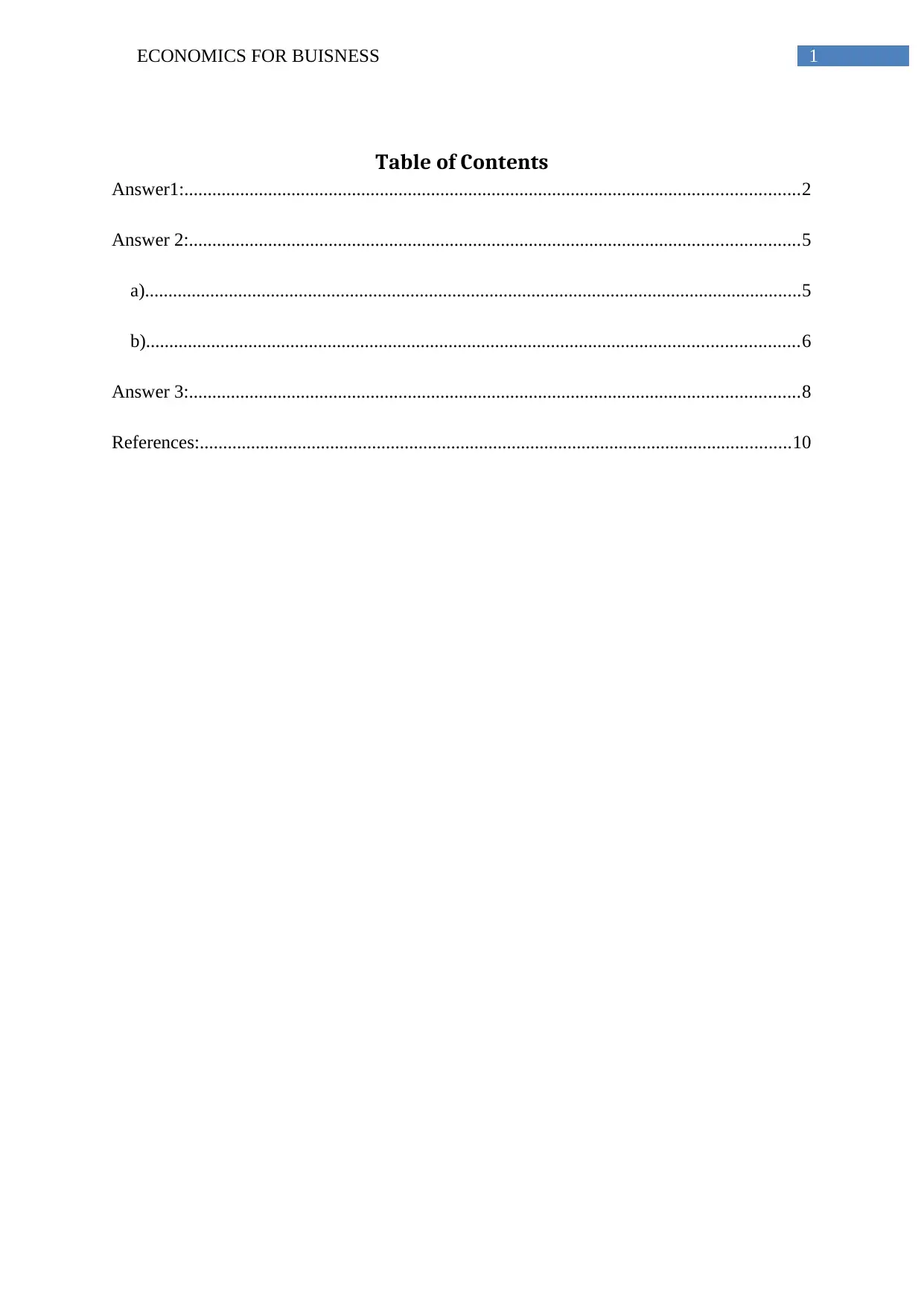
1ECONOMICS FOR BUISNESS
Table of Contents
Answer1:....................................................................................................................................2
Answer 2:...................................................................................................................................5
a).............................................................................................................................................5
b)............................................................................................................................................6
Answer 3:...................................................................................................................................8
References:...............................................................................................................................10
Table of Contents
Answer1:....................................................................................................................................2
Answer 2:...................................................................................................................................5
a).............................................................................................................................................5
b)............................................................................................................................................6
Answer 3:...................................................................................................................................8
References:...............................................................................................................................10

2ECONOMICS FOR BUISNESS
Answer1:
According to the rules of Australian government, excise rate has increased by 12.5%
on the standard 20 Packet of cigarettes, as at 1st January 2018 (Health.gov.au, 2018).
The given price of standard packet of cigarettes is $30 including excise tax rate.
Hence, the before tax price of this packet can be considered as $X. Thus, after imposition
of tax worth 12.5%, the total price is $ (X+ 12.5% of X) which is equal to $30. Hence, by
forming an equation, the value of X can be determined.
(X+ 12.5% of X) = 30
X + (X/8) = 30
8X + X = 30 * 8
9X = 240
X = 240/9
X = 26.67
Therefore, the value of before-tax price is $ 26.67.
As the government has imposed excise duty on tobacco, the production cost of this
specified product has increased significantly. Consequently, sellers can decrease their
amount of tobacco supply in the market due to this higher cost (Lloyd, 2017). With the
help of demand and supply concept, this phenomenon can be described.
Answer1:
According to the rules of Australian government, excise rate has increased by 12.5%
on the standard 20 Packet of cigarettes, as at 1st January 2018 (Health.gov.au, 2018).
The given price of standard packet of cigarettes is $30 including excise tax rate.
Hence, the before tax price of this packet can be considered as $X. Thus, after imposition
of tax worth 12.5%, the total price is $ (X+ 12.5% of X) which is equal to $30. Hence, by
forming an equation, the value of X can be determined.
(X+ 12.5% of X) = 30
X + (X/8) = 30
8X + X = 30 * 8
9X = 240
X = 240/9
X = 26.67
Therefore, the value of before-tax price is $ 26.67.
As the government has imposed excise duty on tobacco, the production cost of this
specified product has increased significantly. Consequently, sellers can decrease their
amount of tobacco supply in the market due to this higher cost (Lloyd, 2017). With the
help of demand and supply concept, this phenomenon can be described.
⊘ This is a preview!⊘
Do you want full access?
Subscribe today to unlock all pages.

Trusted by 1+ million students worldwide
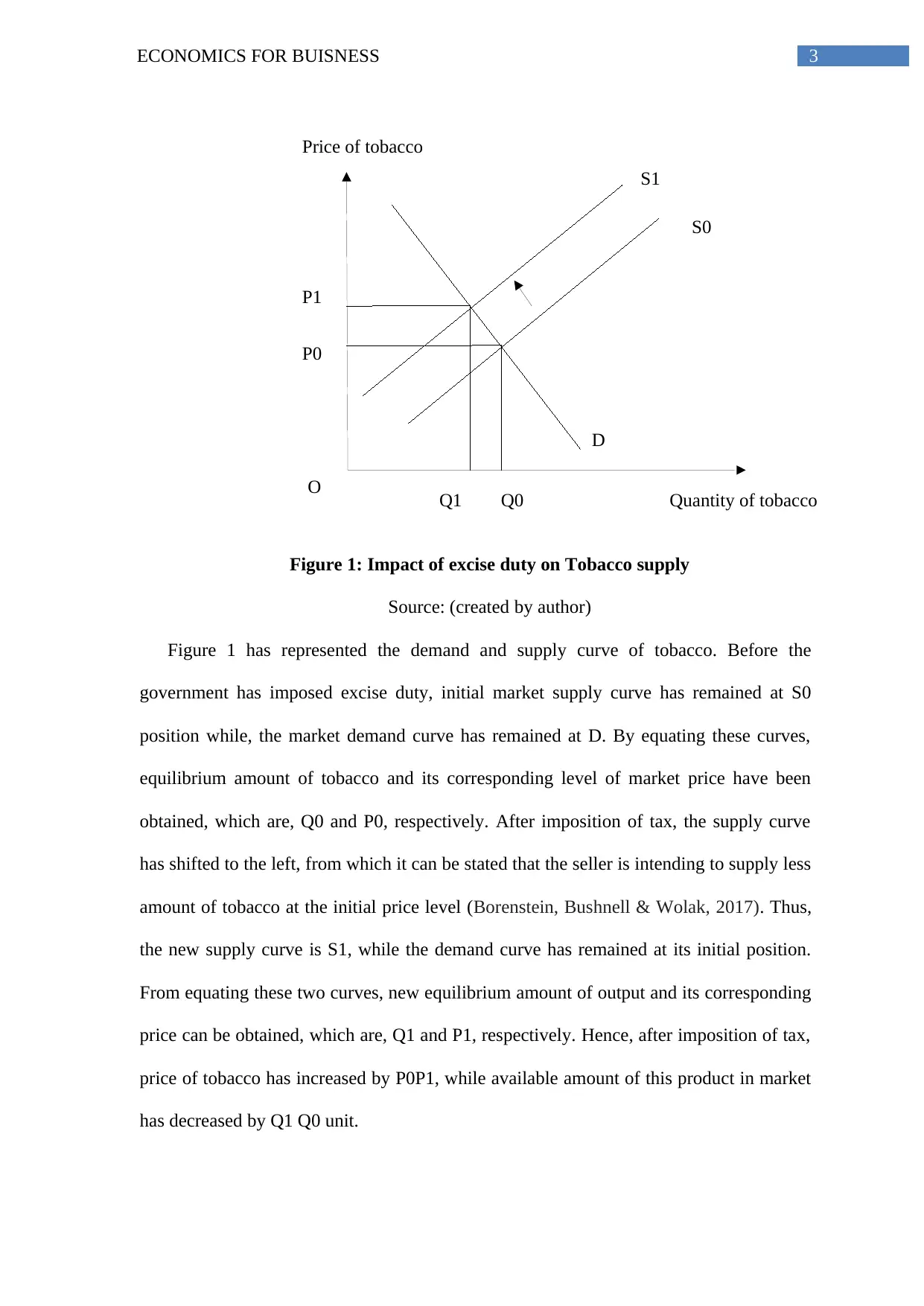
3ECONOMICS FOR BUISNESS
Price of tobacco
O Quantity of tobacco
S0
S1
D
P1
P0
Q1 Q0
Figure 1: Impact of excise duty on Tobacco supply
Source: (created by author)
Figure 1 has represented the demand and supply curve of tobacco. Before the
government has imposed excise duty, initial market supply curve has remained at S0
position while, the market demand curve has remained at D. By equating these curves,
equilibrium amount of tobacco and its corresponding level of market price have been
obtained, which are, Q0 and P0, respectively. After imposition of tax, the supply curve
has shifted to the left, from which it can be stated that the seller is intending to supply less
amount of tobacco at the initial price level (Borenstein, Bushnell & Wolak, 2017). Thus,
the new supply curve is S1, while the demand curve has remained at its initial position.
From equating these two curves, new equilibrium amount of output and its corresponding
price can be obtained, which are, Q1 and P1, respectively. Hence, after imposition of tax,
price of tobacco has increased by P0P1, while available amount of this product in market
has decreased by Q1 Q0 unit.
Price of tobacco
O Quantity of tobacco
S0
S1
D
P1
P0
Q1 Q0
Figure 1: Impact of excise duty on Tobacco supply
Source: (created by author)
Figure 1 has represented the demand and supply curve of tobacco. Before the
government has imposed excise duty, initial market supply curve has remained at S0
position while, the market demand curve has remained at D. By equating these curves,
equilibrium amount of tobacco and its corresponding level of market price have been
obtained, which are, Q0 and P0, respectively. After imposition of tax, the supply curve
has shifted to the left, from which it can be stated that the seller is intending to supply less
amount of tobacco at the initial price level (Borenstein, Bushnell & Wolak, 2017). Thus,
the new supply curve is S1, while the demand curve has remained at its initial position.
From equating these two curves, new equilibrium amount of output and its corresponding
price can be obtained, which are, Q1 and P1, respectively. Hence, after imposition of tax,
price of tobacco has increased by P0P1, while available amount of this product in market
has decreased by Q1 Q0 unit.
Paraphrase This Document
Need a fresh take? Get an instant paraphrase of this document with our AI Paraphraser

4ECONOMICS FOR BUISNESS
Price of tobacco
O Quantity of tobacco
D
P1
P0
Q1 Q0
To determine the actual taxpayer, the nature of demand elasticity is required to
analyse. Price elasticity measures the percentage change in quantity demanded, while
price has changed by 1 percent (Paterakis et al., 2016). For measuring this, other demand
influencing factors, for instance, income of consumers and price of relative commodities
are considered as fixed. People, who consume tobacco, become addicted to it. This
means, at higher price, consumers may not decrease their demand by large extend. In this
context, it can be said that the demand for tobacco is inelastic (Yeh et al.,2017).
Consequently, the product has a steeper demand curve with negative slope.
Figure 2: Steeper demand curve for tobacco
Source: (created by author)
In figure 2, the steeper demand curve for tobacco has been drawn. From this, it can be
stated that, by increasing the price P0P1 unit, quantity demanded for tobacco can be
decreased by Q1 Q0 amount. Moreover, change in price is greater than change in quantity
demanded.
Price of tobacco
O Quantity of tobacco
D
P1
P0
Q1 Q0
To determine the actual taxpayer, the nature of demand elasticity is required to
analyse. Price elasticity measures the percentage change in quantity demanded, while
price has changed by 1 percent (Paterakis et al., 2016). For measuring this, other demand
influencing factors, for instance, income of consumers and price of relative commodities
are considered as fixed. People, who consume tobacco, become addicted to it. This
means, at higher price, consumers may not decrease their demand by large extend. In this
context, it can be said that the demand for tobacco is inelastic (Yeh et al.,2017).
Consequently, the product has a steeper demand curve with negative slope.
Figure 2: Steeper demand curve for tobacco
Source: (created by author)
In figure 2, the steeper demand curve for tobacco has been drawn. From this, it can be
stated that, by increasing the price P0P1 unit, quantity demanded for tobacco can be
decreased by Q1 Q0 amount. Moreover, change in price is greater than change in quantity
demanded.
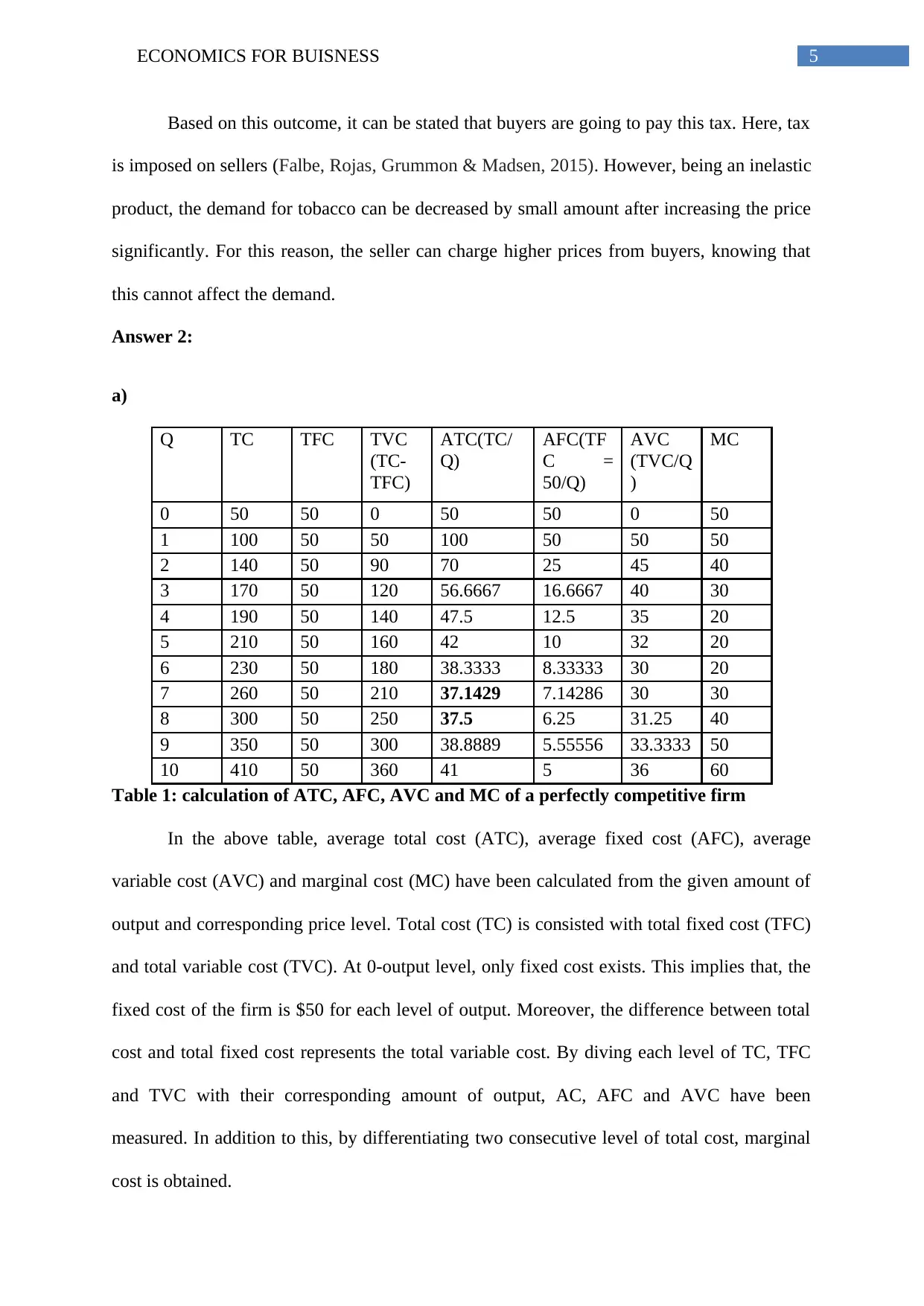
5ECONOMICS FOR BUISNESS
Based on this outcome, it can be stated that buyers are going to pay this tax. Here, tax
is imposed on sellers (Falbe, Rojas, Grummon & Madsen, 2015). However, being an inelastic
product, the demand for tobacco can be decreased by small amount after increasing the price
significantly. For this reason, the seller can charge higher prices from buyers, knowing that
this cannot affect the demand.
Answer 2:
a)
Q TC TFC TVC
(TC-
TFC)
ATC(TC/
Q)
AFC(TF
C =
50/Q)
AVC
(TVC/Q
)
MC
0 50 50 0 50 50 0 50
1 100 50 50 100 50 50 50
2 140 50 90 70 25 45 40
3 170 50 120 56.6667 16.6667 40 30
4 190 50 140 47.5 12.5 35 20
5 210 50 160 42 10 32 20
6 230 50 180 38.3333 8.33333 30 20
7 260 50 210 37.1429 7.14286 30 30
8 300 50 250 37.5 6.25 31.25 40
9 350 50 300 38.8889 5.55556 33.3333 50
10 410 50 360 41 5 36 60
Table 1: calculation of ATC, AFC, AVC and MC of a perfectly competitive firm
In the above table, average total cost (ATC), average fixed cost (AFC), average
variable cost (AVC) and marginal cost (MC) have been calculated from the given amount of
output and corresponding price level. Total cost (TC) is consisted with total fixed cost (TFC)
and total variable cost (TVC). At 0-output level, only fixed cost exists. This implies that, the
fixed cost of the firm is $50 for each level of output. Moreover, the difference between total
cost and total fixed cost represents the total variable cost. By diving each level of TC, TFC
and TVC with their corresponding amount of output, AC, AFC and AVC have been
measured. In addition to this, by differentiating two consecutive level of total cost, marginal
cost is obtained.
Based on this outcome, it can be stated that buyers are going to pay this tax. Here, tax
is imposed on sellers (Falbe, Rojas, Grummon & Madsen, 2015). However, being an inelastic
product, the demand for tobacco can be decreased by small amount after increasing the price
significantly. For this reason, the seller can charge higher prices from buyers, knowing that
this cannot affect the demand.
Answer 2:
a)
Q TC TFC TVC
(TC-
TFC)
ATC(TC/
Q)
AFC(TF
C =
50/Q)
AVC
(TVC/Q
)
MC
0 50 50 0 50 50 0 50
1 100 50 50 100 50 50 50
2 140 50 90 70 25 45 40
3 170 50 120 56.6667 16.6667 40 30
4 190 50 140 47.5 12.5 35 20
5 210 50 160 42 10 32 20
6 230 50 180 38.3333 8.33333 30 20
7 260 50 210 37.1429 7.14286 30 30
8 300 50 250 37.5 6.25 31.25 40
9 350 50 300 38.8889 5.55556 33.3333 50
10 410 50 360 41 5 36 60
Table 1: calculation of ATC, AFC, AVC and MC of a perfectly competitive firm
In the above table, average total cost (ATC), average fixed cost (AFC), average
variable cost (AVC) and marginal cost (MC) have been calculated from the given amount of
output and corresponding price level. Total cost (TC) is consisted with total fixed cost (TFC)
and total variable cost (TVC). At 0-output level, only fixed cost exists. This implies that, the
fixed cost of the firm is $50 for each level of output. Moreover, the difference between total
cost and total fixed cost represents the total variable cost. By diving each level of TC, TFC
and TVC with their corresponding amount of output, AC, AFC and AVC have been
measured. In addition to this, by differentiating two consecutive level of total cost, marginal
cost is obtained.
⊘ This is a preview!⊘
Do you want full access?
Subscribe today to unlock all pages.

Trusted by 1+ million students worldwide

6ECONOMICS FOR BUISNESS
In the short-run, under perfectly competitive market, equilibrium amount of output
can be obtained by equating a firm’s marginal cost with marginal revenue, which also
represents a fixed price (Kolmar & Hoffmann, 2018). Here, the given price is $35. However,
at 7 unit of output, marginal cost is $30 while for 8 unit of output, this amount is $40. Hence,
the producer may produce any amount of output between 7 and 8, by incurring losses. In the
long run, a perfectly competitive firm earns normal profit only. This means, price and
marginal cost equate with each other, at the minimum point of AC (Aghion et al., 2015).
From this figure, it can be seen that the minimum amount of AC is $ 37.14, at 7 unit of
output. However, given price is $35, which is lower compare to the minimum value of AC.
Thus, the firm has left the market in long-run as it has incurred losses.
b)
Monopolistically Competitive Market:
The monopolistically competitive market includes the characteristics of both perfect
competition and monopoly. Hence, this market has large number of sellers along with large
number of buyers (Schweinberger & Suedekum, 2015). The market does not possess any
barriers, which means; a seller can easily enter into the market or can leave the one. Those
characteristics are similar with the perfectly competitive market. Each firm is selling almost
same products, which are not closely substitute. Hence, product differentiation can be seen
over here for which, each market operates like monopoly. Every seller can take independent
decision regarding market price and possesses a negatively sloped demand curve. Due to
product differentiation, each firm bears advertisement cost.
In the short-run, under perfectly competitive market, equilibrium amount of output
can be obtained by equating a firm’s marginal cost with marginal revenue, which also
represents a fixed price (Kolmar & Hoffmann, 2018). Here, the given price is $35. However,
at 7 unit of output, marginal cost is $30 while for 8 unit of output, this amount is $40. Hence,
the producer may produce any amount of output between 7 and 8, by incurring losses. In the
long run, a perfectly competitive firm earns normal profit only. This means, price and
marginal cost equate with each other, at the minimum point of AC (Aghion et al., 2015).
From this figure, it can be seen that the minimum amount of AC is $ 37.14, at 7 unit of
output. However, given price is $35, which is lower compare to the minimum value of AC.
Thus, the firm has left the market in long-run as it has incurred losses.
b)
Monopolistically Competitive Market:
The monopolistically competitive market includes the characteristics of both perfect
competition and monopoly. Hence, this market has large number of sellers along with large
number of buyers (Schweinberger & Suedekum, 2015). The market does not possess any
barriers, which means; a seller can easily enter into the market or can leave the one. Those
characteristics are similar with the perfectly competitive market. Each firm is selling almost
same products, which are not closely substitute. Hence, product differentiation can be seen
over here for which, each market operates like monopoly. Every seller can take independent
decision regarding market price and possesses a negatively sloped demand curve. Due to
product differentiation, each firm bears advertisement cost.
Paraphrase This Document
Need a fresh take? Get an instant paraphrase of this document with our AI Paraphraser
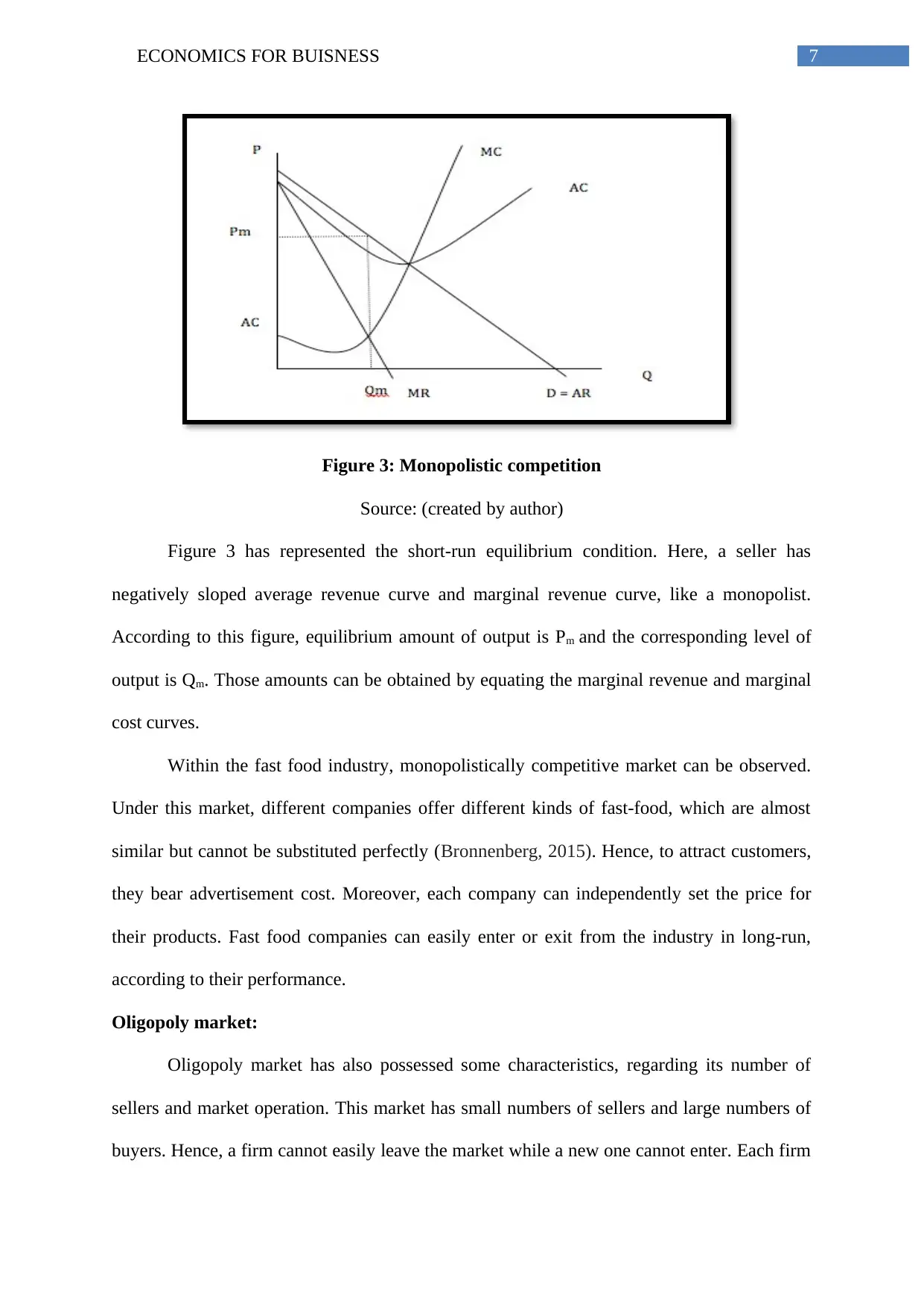
7ECONOMICS FOR BUISNESS
Figure 3: Monopolistic competition
Source: (created by author)
Figure 3 has represented the short-run equilibrium condition. Here, a seller has
negatively sloped average revenue curve and marginal revenue curve, like a monopolist.
According to this figure, equilibrium amount of output is Pm and the corresponding level of
output is Qm. Those amounts can be obtained by equating the marginal revenue and marginal
cost curves.
Within the fast food industry, monopolistically competitive market can be observed.
Under this market, different companies offer different kinds of fast-food, which are almost
similar but cannot be substituted perfectly (Bronnenberg, 2015). Hence, to attract customers,
they bear advertisement cost. Moreover, each company can independently set the price for
their products. Fast food companies can easily enter or exit from the industry in long-run,
according to their performance.
Oligopoly market:
Oligopoly market has also possessed some characteristics, regarding its number of
sellers and market operation. This market has small numbers of sellers and large numbers of
buyers. Hence, a firm cannot easily leave the market while a new one cannot enter. Each firm
Figure 3: Monopolistic competition
Source: (created by author)
Figure 3 has represented the short-run equilibrium condition. Here, a seller has
negatively sloped average revenue curve and marginal revenue curve, like a monopolist.
According to this figure, equilibrium amount of output is Pm and the corresponding level of
output is Qm. Those amounts can be obtained by equating the marginal revenue and marginal
cost curves.
Within the fast food industry, monopolistically competitive market can be observed.
Under this market, different companies offer different kinds of fast-food, which are almost
similar but cannot be substituted perfectly (Bronnenberg, 2015). Hence, to attract customers,
they bear advertisement cost. Moreover, each company can independently set the price for
their products. Fast food companies can easily enter or exit from the industry in long-run,
according to their performance.
Oligopoly market:
Oligopoly market has also possessed some characteristics, regarding its number of
sellers and market operation. This market has small numbers of sellers and large numbers of
buyers. Hence, a firm cannot easily leave the market while a new one cannot enter. Each firm

8ECONOMICS FOR BUISNESS
follows the reaction of other competitive firms, which means, interdependency is seen within
this market (Newbery & Greve, 2017). Those firms either can maximise profit or can
maximise revenue. For this reason, kinked shaped demand curve can be seen over here. This
kinked demand curve is shown in the following diagram.
Figure 4: Oligopoly market
Source: ( created by author)
The upward portion of kinked demand curve is elastic, while the downward portion is
inelastic. In the above figure, the market can maximise its profit at Qe level of output while
corresponding level of price is Pe.
This form of market can be observed within the banking industry of Australia. This
industry contains four large banks, namely, the National Australian Bank, Commonwealth
Bank of Australia, Westpac and Australian and New Zealand Banking Group (Tyers, 2015).
Each bank has set their rate of interest by assuming the interest rate of other banks.
Answer 3:
The economic rationale regarding the merging of local government councils of some
states of Australia can be described as follows:
Increasing capacity of local government: It is difficult for a local government to take any
major decision individually. In addition to this, the state government sometimes gives huge
follows the reaction of other competitive firms, which means, interdependency is seen within
this market (Newbery & Greve, 2017). Those firms either can maximise profit or can
maximise revenue. For this reason, kinked shaped demand curve can be seen over here. This
kinked demand curve is shown in the following diagram.
Figure 4: Oligopoly market
Source: ( created by author)
The upward portion of kinked demand curve is elastic, while the downward portion is
inelastic. In the above figure, the market can maximise its profit at Qe level of output while
corresponding level of price is Pe.
This form of market can be observed within the banking industry of Australia. This
industry contains four large banks, namely, the National Australian Bank, Commonwealth
Bank of Australia, Westpac and Australian and New Zealand Banking Group (Tyers, 2015).
Each bank has set their rate of interest by assuming the interest rate of other banks.
Answer 3:
The economic rationale regarding the merging of local government councils of some
states of Australia can be described as follows:
Increasing capacity of local government: It is difficult for a local government to take any
major decision individually. In addition to this, the state government sometimes gives huge
⊘ This is a preview!⊘
Do you want full access?
Subscribe today to unlock all pages.

Trusted by 1+ million students worldwide
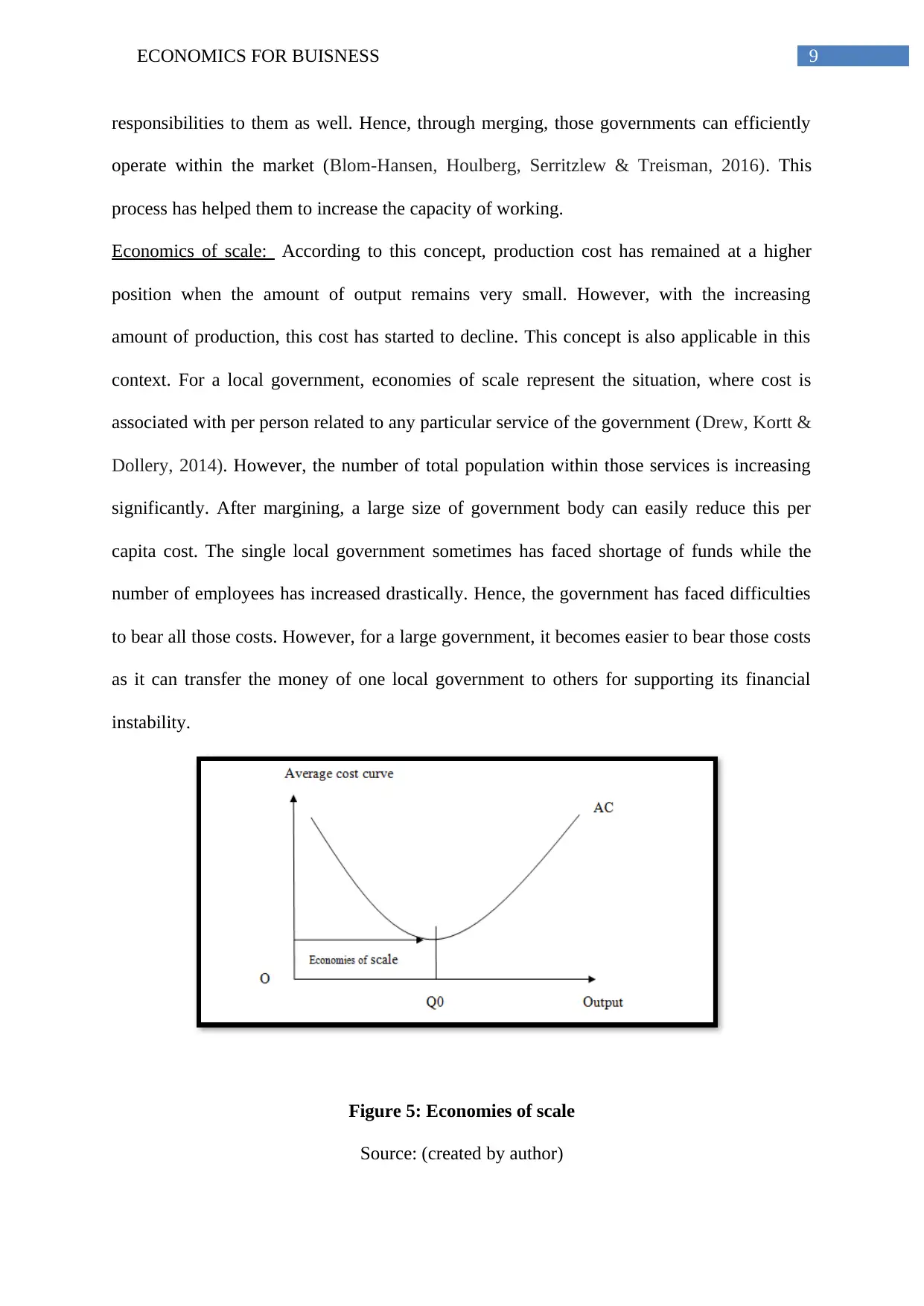
9ECONOMICS FOR BUISNESS
responsibilities to them as well. Hence, through merging, those governments can efficiently
operate within the market (Blom-Hansen, Houlberg, Serritzlew & Treisman, 2016). This
process has helped them to increase the capacity of working.
Economics of scale: According to this concept, production cost has remained at a higher
position when the amount of output remains very small. However, with the increasing
amount of production, this cost has started to decline. This concept is also applicable in this
context. For a local government, economies of scale represent the situation, where cost is
associated with per person related to any particular service of the government (Drew, Kortt &
Dollery, 2014). However, the number of total population within those services is increasing
significantly. After margining, a large size of government body can easily reduce this per
capita cost. The single local government sometimes has faced shortage of funds while the
number of employees has increased drastically. Hence, the government has faced difficulties
to bear all those costs. However, for a large government, it becomes easier to bear those costs
as it can transfer the money of one local government to others for supporting its financial
instability.
Figure 5: Economies of scale
Source: (created by author)
responsibilities to them as well. Hence, through merging, those governments can efficiently
operate within the market (Blom-Hansen, Houlberg, Serritzlew & Treisman, 2016). This
process has helped them to increase the capacity of working.
Economics of scale: According to this concept, production cost has remained at a higher
position when the amount of output remains very small. However, with the increasing
amount of production, this cost has started to decline. This concept is also applicable in this
context. For a local government, economies of scale represent the situation, where cost is
associated with per person related to any particular service of the government (Drew, Kortt &
Dollery, 2014). However, the number of total population within those services is increasing
significantly. After margining, a large size of government body can easily reduce this per
capita cost. The single local government sometimes has faced shortage of funds while the
number of employees has increased drastically. Hence, the government has faced difficulties
to bear all those costs. However, for a large government, it becomes easier to bear those costs
as it can transfer the money of one local government to others for supporting its financial
instability.
Figure 5: Economies of scale
Source: (created by author)
Paraphrase This Document
Need a fresh take? Get an instant paraphrase of this document with our AI Paraphraser

10ECONOMICS FOR BUISNESS
Based on figure 5, it can be stated that the economies of scale of an organisation
operates, when it shift from origin to Q0.
Economies of scope: When some firms take decision of joint production, economies of scope
can be seen. Based on this concept, it can be said that this scope has helped the producer to
produce various products under a single entity with comparatively lower costs. This concept
is also applicable for the merging of local governments (Blom-Hansen, Houlberg, Serritzlew
& Treisman, 2016). The country can experience a stable political condition if a single
government performs all services. Moreover, this in turn has helped this organisation to
reduce all operational costs.
Figure 6: Economies of scope
Source: (created by author)
According to figure 6, cost of production for an organisation has decreased from C0
to C1, as it has started to produce more than one type of output, that is, Q1.
Hence, from those above concepts, it can be stated that through merging, Australia
has experienced a well governing body that has economical significance.
Based on figure 5, it can be stated that the economies of scale of an organisation
operates, when it shift from origin to Q0.
Economies of scope: When some firms take decision of joint production, economies of scope
can be seen. Based on this concept, it can be said that this scope has helped the producer to
produce various products under a single entity with comparatively lower costs. This concept
is also applicable for the merging of local governments (Blom-Hansen, Houlberg, Serritzlew
& Treisman, 2016). The country can experience a stable political condition if a single
government performs all services. Moreover, this in turn has helped this organisation to
reduce all operational costs.
Figure 6: Economies of scope
Source: (created by author)
According to figure 6, cost of production for an organisation has decreased from C0
to C1, as it has started to produce more than one type of output, that is, Q1.
Hence, from those above concepts, it can be stated that through merging, Australia
has experienced a well governing body that has economical significance.
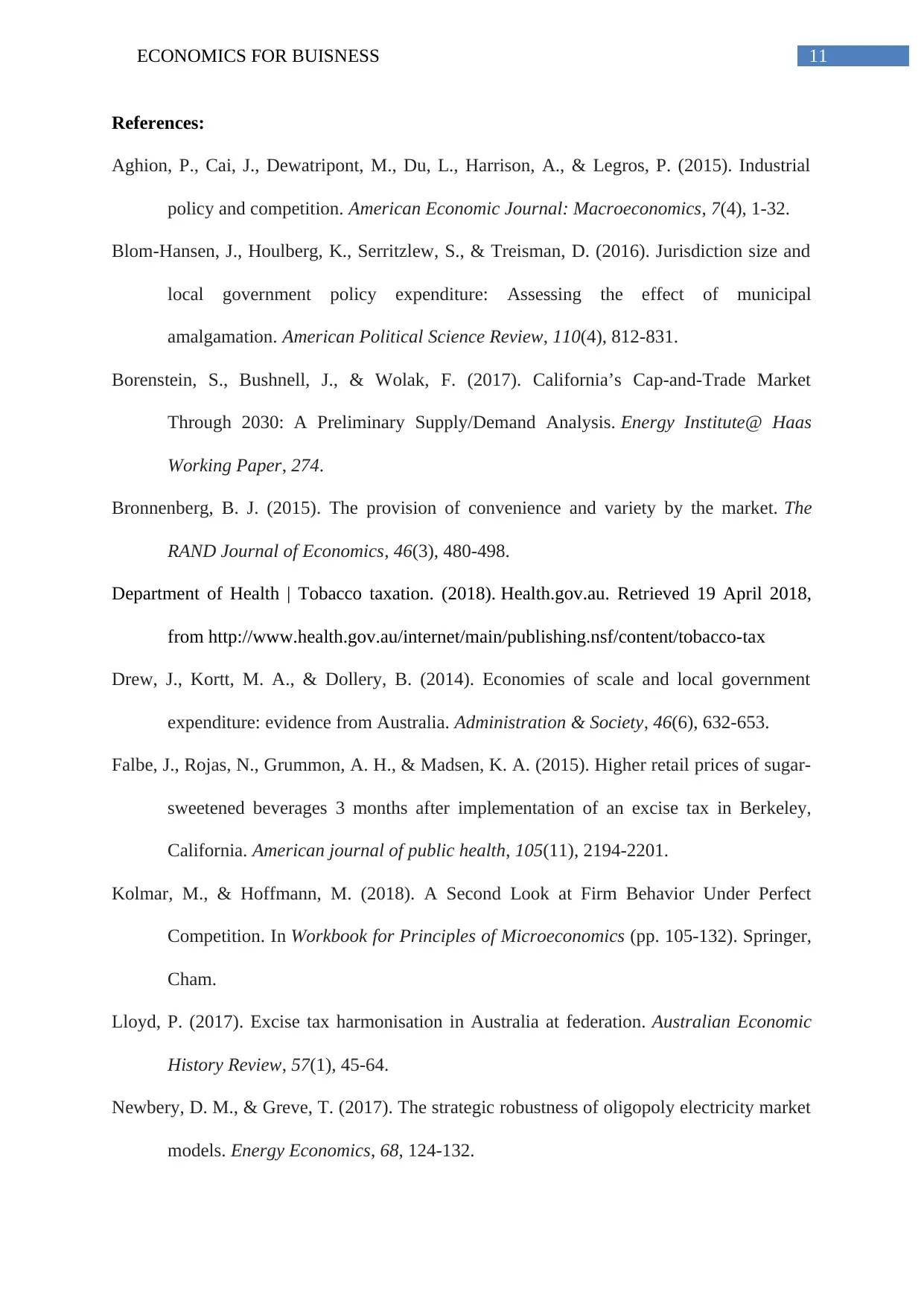
11ECONOMICS FOR BUISNESS
References:
Aghion, P., Cai, J., Dewatripont, M., Du, L., Harrison, A., & Legros, P. (2015). Industrial
policy and competition. American Economic Journal: Macroeconomics, 7(4), 1-32.
Blom-Hansen, J., Houlberg, K., Serritzlew, S., & Treisman, D. (2016). Jurisdiction size and
local government policy expenditure: Assessing the effect of municipal
amalgamation. American Political Science Review, 110(4), 812-831.
Borenstein, S., Bushnell, J., & Wolak, F. (2017). California’s Cap-and-Trade Market
Through 2030: A Preliminary Supply/Demand Analysis. Energy Institute@ Haas
Working Paper, 274.
Bronnenberg, B. J. (2015). The provision of convenience and variety by the market. The
RAND Journal of Economics, 46(3), 480-498.
Department of Health | Tobacco taxation. (2018). Health.gov.au. Retrieved 19 April 2018,
from http://www.health.gov.au/internet/main/publishing.nsf/content/tobacco-tax
Drew, J., Kortt, M. A., & Dollery, B. (2014). Economies of scale and local government
expenditure: evidence from Australia. Administration & Society, 46(6), 632-653.
Falbe, J., Rojas, N., Grummon, A. H., & Madsen, K. A. (2015). Higher retail prices of sugar-
sweetened beverages 3 months after implementation of an excise tax in Berkeley,
California. American journal of public health, 105(11), 2194-2201.
Kolmar, M., & Hoffmann, M. (2018). A Second Look at Firm Behavior Under Perfect
Competition. In Workbook for Principles of Microeconomics (pp. 105-132). Springer,
Cham.
Lloyd, P. (2017). Excise tax harmonisation in Australia at federation. Australian Economic
History Review, 57(1), 45-64.
Newbery, D. M., & Greve, T. (2017). The strategic robustness of oligopoly electricity market
models. Energy Economics, 68, 124-132.
References:
Aghion, P., Cai, J., Dewatripont, M., Du, L., Harrison, A., & Legros, P. (2015). Industrial
policy and competition. American Economic Journal: Macroeconomics, 7(4), 1-32.
Blom-Hansen, J., Houlberg, K., Serritzlew, S., & Treisman, D. (2016). Jurisdiction size and
local government policy expenditure: Assessing the effect of municipal
amalgamation. American Political Science Review, 110(4), 812-831.
Borenstein, S., Bushnell, J., & Wolak, F. (2017). California’s Cap-and-Trade Market
Through 2030: A Preliminary Supply/Demand Analysis. Energy Institute@ Haas
Working Paper, 274.
Bronnenberg, B. J. (2015). The provision of convenience and variety by the market. The
RAND Journal of Economics, 46(3), 480-498.
Department of Health | Tobacco taxation. (2018). Health.gov.au. Retrieved 19 April 2018,
from http://www.health.gov.au/internet/main/publishing.nsf/content/tobacco-tax
Drew, J., Kortt, M. A., & Dollery, B. (2014). Economies of scale and local government
expenditure: evidence from Australia. Administration & Society, 46(6), 632-653.
Falbe, J., Rojas, N., Grummon, A. H., & Madsen, K. A. (2015). Higher retail prices of sugar-
sweetened beverages 3 months after implementation of an excise tax in Berkeley,
California. American journal of public health, 105(11), 2194-2201.
Kolmar, M., & Hoffmann, M. (2018). A Second Look at Firm Behavior Under Perfect
Competition. In Workbook for Principles of Microeconomics (pp. 105-132). Springer,
Cham.
Lloyd, P. (2017). Excise tax harmonisation in Australia at federation. Australian Economic
History Review, 57(1), 45-64.
Newbery, D. M., & Greve, T. (2017). The strategic robustness of oligopoly electricity market
models. Energy Economics, 68, 124-132.
⊘ This is a preview!⊘
Do you want full access?
Subscribe today to unlock all pages.

Trusted by 1+ million students worldwide
1 out of 13
Related Documents
Your All-in-One AI-Powered Toolkit for Academic Success.
+13062052269
info@desklib.com
Available 24*7 on WhatsApp / Email
![[object Object]](/_next/static/media/star-bottom.7253800d.svg)
Unlock your academic potential
Copyright © 2020–2025 A2Z Services. All Rights Reserved. Developed and managed by ZUCOL.




